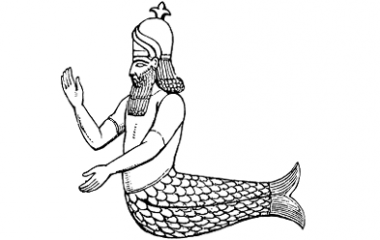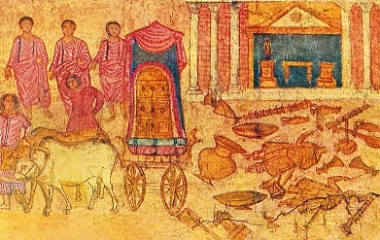- Pronunciation: dey-gon
- Origin: Philistine
- Role: Fertility
- Symbols: Fish, grain
- Wife: Nanshe
Who Is Dagon?
The Philistines, a community of Canaanites, were an Aegean people who settled on the southern coast of the area we now know as Israel during the 12th century B.C. Their pagan god Dagon, also referred to as Dagan, was a fertility deity who eventually morphed into an important Semitic god.
Dagon was represented by both grain and fish, symbols of fertility and multiplying. Often depicted with the torso of a man and the tail of a fish, he may very well be the first merman, predating even the merfolk (mermaids and mermen) of Greek mythological legends.
In the Hebrew Semitic dialect, the root of Dagon, dag, means fish, and Dagan or Dagon is an endearing term, meaning little fish. Some linguists interpret the name as meaning grain in the ancient language of the Canaanites.
Origin
The first known appearance of Dagon is in the records of Mari, Syria, in ancient Mesopotamia from 2500 B.C. Later, he was mentioned in the inscriptions of Assyria and Babylonia as a protector and warrior god, and in the texts of the port city of Ugarit in ancient Syria. A temple in his honor stood in this ancient place. At that time, he had risen to the third god of the pantheon along with El and Baal. Archeological expeditions also uncovered a temple of Baal in the city of Ugarit.
The Philistines were originally from the Aegean area near Greece, but they sailed to the coast of Palestine about the same time as the Israelites entered the promised land from the east around 1100 B.C. The Philistine culture and the abilities of the Philistine people were relatively sophisticated. They produced olive oil, worked with iron, and developed cities. Due to their strategic locations, they were the dominant trade force with other nations. The five main cities along the main trade route were Ashdod, Ashkelon, Gaza, Ekron, and Gath.
Family
In earlier mythology, the companion of Dagon was known as Belatu, meaning lady. Other mythologists associate him with the goddess Nanshe, who was a deity of fertility and fishing, and the child of Enki. She is the legendary sister of Astarte (Asherah).
Historical Influence
Ark of the Covenant
The Ark of the Covenant contained the holy tablets on which the Ten Commandments were written. The Israelites carried the ark with them during their 40 years in the desert. There are many miracles associated with the ark, including the parting of the waters of the Jordan River, which allowed them to cross into the land of Canaan.
According to the biblical legend, the Philistines captured the ark and took it to their capital city Ashdod to place it in the temple of Dagon. The next day they found the idol of Dagan had fallen on its face. Thinking it was a mishap, they replaced the statue. They returned the following day and found the statue decapitated. Shortly after, the city was hit with a plague of mice, and the people got hemorrhoids!
So the Philistines move the ark to another city named Gath and then moved it again to Ekron. Each of those cities got plagues too. The ark became a literal pain in the ass, not to mention the mice and vermin that accompanied it. Finally, after seven months, the Philistines sent it back to the Israelites along with gifts.
Ichthys
The Jesus fish is a symbol is called an ichthys, which means fish. When written in the Greek alphabet, it is also an acronym for the words Jesus Christ Son of God, Savior. Fish symbolism dates back much further than the cross and it has been theorized that early Christians adopted some symbolism from the ancient pagan Mesopotamians.
The Catholic Pope and bishops wear a tall hat called a mitre, which is shaped similarly to the headdress of Dagon. Some say it represents the head of Dagon with an open mouth, which is why it has a split top and pointy shape. Some say the reason the Pope wears it is to carry on the tradition of the mitre worn by the very first pope who knew the secrets of Dagon.
Modern Influence
Dagon has made many appearances in literature and pop culture. He is the demon lord in the Dungeons & Dragons game. In the movie Conan the Destroyer, Dagoth the evil god is named for Dagon. During the television series Buffy the Vampire Slayer, the Order of Dagon transformed energy into matter and protected the Key by turning into a human.
It seems the ancient Dagon was a big part of the life of the ancient Philistines, Assyrians and Babylonians and other Canaanites. He is mentioned several times in the Hebrew Bible and his symbolism permeates Catholicism. Dagon may have been the first mermen, followed by many fish deities in more recent mythologies. Dagon survives as a supernatural character in our popular culture today. He has had a long run, and his legend dates back to the 12th century B.C.










